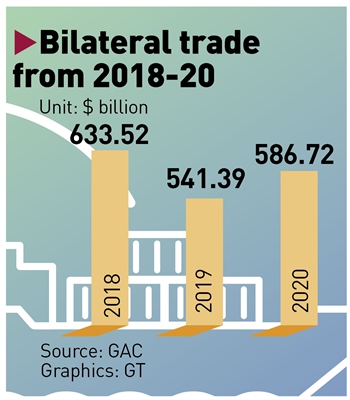A combine and a grain cart work in a soybean field of Pellett family’s farm in Atlantic, a small city in Iowa, the United States. (Xinhua/Wang Ying)
Trade between China and the US remained robust during the first 11 months of the year, hitting $682.32 billion, a year-on-year increase of 30.2 percent, Chinese customs data showed on Tuesday, even as bilateral ties continue on a downward spiral due to the US’ constant aggression toward China.
Bilateral trade could reach a record high at the end of the year, as US continues to purchase more Chinese manufactured products amid record inflation levels and as China expands imports of US agricultural, energy and other products, Chinese experts noted.
However, as Washington continues its hostile approach, China-US ties will remain in “hot economics, cold politics,” experts added.
In the first 11 months of 2021, China’s exports to the US increased 28.3 percent year-on-year, while imports grew 36.9 percent year-on-year, according to official data on Tuesday. In November, bilateral trade stood at $72.49 billion, jumping from $66.79 billion in the previous month.
The US has to increase imports from China in order to relieve its domestic supply shortages, Beijing-based economist Tian Yun told the Global Times on Tuesday. “If not, US inflation is likely to keep rising.”
Meanwhile, China has also been increasing imports of some commodities such as energy products and airplanes from the US, Gao Lingyun, an expert at the Chinese Academy of Social Sciences in Beijing, told the Global Times on Tuesday.
In November, China imported 8.57 million tons of soybeans, an increase of 67.7 percent month-on-month, of which the imports from the US also increased, according to analysts.
Jiao Shanwei, editor-in-chief of industry news website cngrain.com, said that soybean imports picked up during the peak export season for soybeans from North America as hurricanes in the US and soaring rates for sea freight and cargo containers had delayed the shipments previously.
Jiao added that food importers in China have also been ramping up the purchase of soybeans and other necessities for the upcoming New Year and the Spring Festival holidays.
On the energy front, China’s state-owned oil giant Sinopec signed a massive deal with US-based Venture Global LNG on November 4 to buy 4 million tons of liquefied natural gas (LNG) annually for 20 years, the largest long-term LNG deal ever signed between the world’s two largest economies, the Xinhua News Agency reported.
Going forward, Tian expected a new record for China-US trade in 2021, which would likely continue on a strong path into next year.
Gao pointed out that the robust trade has the potential to reach a higher level, since the end of the year will usually be a high point as the holiday season normally boosts trade.

Graphics: GT
However, Gao noted that the reading did not fully meet expectations due to the tightened epidemic prevention policy amid the Omicron variant and disrupted logistics in the US.
“Although the US side has recognized that China-US cooperation is mutually beneficial, some opposing voices in the US may become a hidden worry for bilateral economic and trade cooperation in the future,” said Gao.
As the phase one trade deal will soon expire at the end of 2021, analysts noted that the two countries need an opportunity to discuss bilateral trade.
“If the US scraps the punitive tariffs on Chinese products, there would be a win-win outcome for both as it will help relieve the US inflationary pressure, while increasing China’s exports to the US,” Tian said, adding that the current landscape of “hot economics, cold politics” will continue between the world’s two largest economies.
US Treasury Secretary Janet Yellen told CBS in an interview earlier in November that removing the trade tariffs that the Trump administration imposed on Chinese goods “would make some difference” to elevated US inflation.
Global Times




